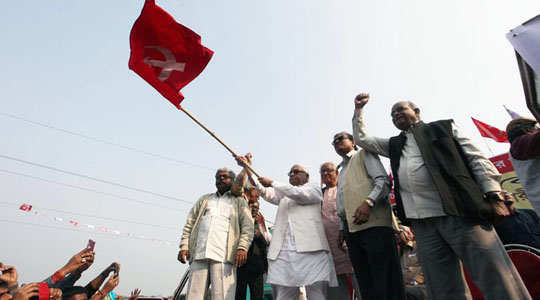New Delhi, Jan 17: At a meeting in Singur on Saturday, former West Bengal chief minister Buddhadeb Bhattacharjee issued an open appeal to the Congress to join hands with the Left Front to defeat Mamata Banerjee’s Trinamool Congress in the assembly elections due later this year.

The thought of a broad coalition against the Trinamool has occupied the minds of a significant section of the CPM leadership in recent times; the appeal to the Congress by Bhattacharjee, who is also a former Politburo member, is the first from a public platform.
“What is the Congress leadership thinking today? We are not alone. Come and join us. Every opposition party should come and join hands to dislodge this undemocratic government,” Bhattacharjee said.
The Congress reacted with caution, saying decision-making of this kind must follow a “system”. On Bhattacharjee’s appeal for a joint front, C P Joshi, general secretary in charge of West Bengal, said: “That is the perception of the CPM. Congress will take a decision after giving due weightage to views of workers and the leadership. Congress has a system to come to such decisions.”
The CPM state committee is likely to make a formal proposal to the Politburo on approaching the Congress for a tie-up in the coming weeks, it is learnt. CPM general secretary Sitaram Yechury had said earlier that once the state unit takes a decision and sends a proposal, the central committee would discuss it before taking a decision. His comments then focussed on technicalities of the process of decision-making, and did not rule out an understanding with the Congress.
The other key signal from the CPM meeting appeared to be the emergence of a consensus on a “reassessment” of the Bhattacharjee government’s line on the Tata Motors plant.
The entire Left leadership present at Singur iterated that the policy had been right — and if followed through, could have brought in sweeping changes and prosperity to Bengal. Bhattacharjee’s attempts to acquire land for the plant had triggered a wave of protests that have been seen to have led ultimately to the downfall, in the elections of 2011, of the 34-year-old Left regime in the state.
Left leaders from Bhattacharjee to Politburo member Biman Bose resolved to “do it again” in Singur, “once the people of Bengal hoist the red flag on Nabanna, the seat of Mamata Banerjee’s power”. The Left Front and 113 mass organisations aligned to it kicked off a padayatra that will cover 192 km through seven South Bengal districts before ending in Salboni in West Midnapore on January 22.
Bhattacharjee, who visited Singur for the first time since 2006, when land acquisition for the Tata project began, said the state had become a “graveyard” for industry under the Trinamool government. “Like Singur, Salboni too was set to get a Rs 35,000 crore steel plant. Where is that now?” he asked.
Months before the elections — the term of the West Bengal assembly ends on May 29 — the Left chose Singur for a public meeting to highlight the continuing stalemate over the return of land to farmers who had been unwilling to part with it — the first promise made by the Mamata Banerjee cabinet.
“You were twice unlucky. You have neither got compensation nor your land back,” speakers told the meeting that saw a significant attendance of Singur villagers. A farmer who said he had lost land, said: “We wanted our land back but we now regret having refused to give our land. We have lost land and now live on the charity of the government, on Rs 2,000 a month and some subsidised foodgrains.” The farmer declined to be identified.
Congress sources in New Delhi said that while the party’s leadership in Bengal was dead against an alliance with the Trinamool, it was largely silent on an understanding with the Left. The Congress central leadership, on the other hand, appears inclined towards joining hands with Mamata — preferring the force that could be its alliance partner in the Lok Sabha elections of 2019, and win the largest number of seats in the state.
The Congress high command has mostly agreed with the views of the state units on forming alliances for state elections. Despite being in favour of an alliance with the JMM in Jharkhand, for example, it had gone alone because the state unit had wanted it that way.
“We are seized of the matter,” Joshi said. “The question of alliance or no alliance is before us. The process (of arriving at a decision) is continuing. We will consider the views of the workers and leaders and the political scenario in the country before taking a decision.”
In Kolkata, the Trinamool Congress mocked Bhattacharjee’s call for industrialisation, and said it was the erstwhile Left Front regime that had “destroyed” the industrial atmosphere of the state, PTI reported.
“We too believe that there is need for industrialisation and have taken up plans for it. We don’t believe in fake slogans like CPM. It was CPM which destroyed the industrial atmosphere of the state,” TMC secretary general Partha Chatterjee was quoted as saying. “Criminals”, Chatterjee said, “always have the tendency to visit the crime spot again. So the place where heinous crimes like loot of farmland, killing of people and rapes were committed, has been revisited by them (CPM)”.





Comments
Add new comment